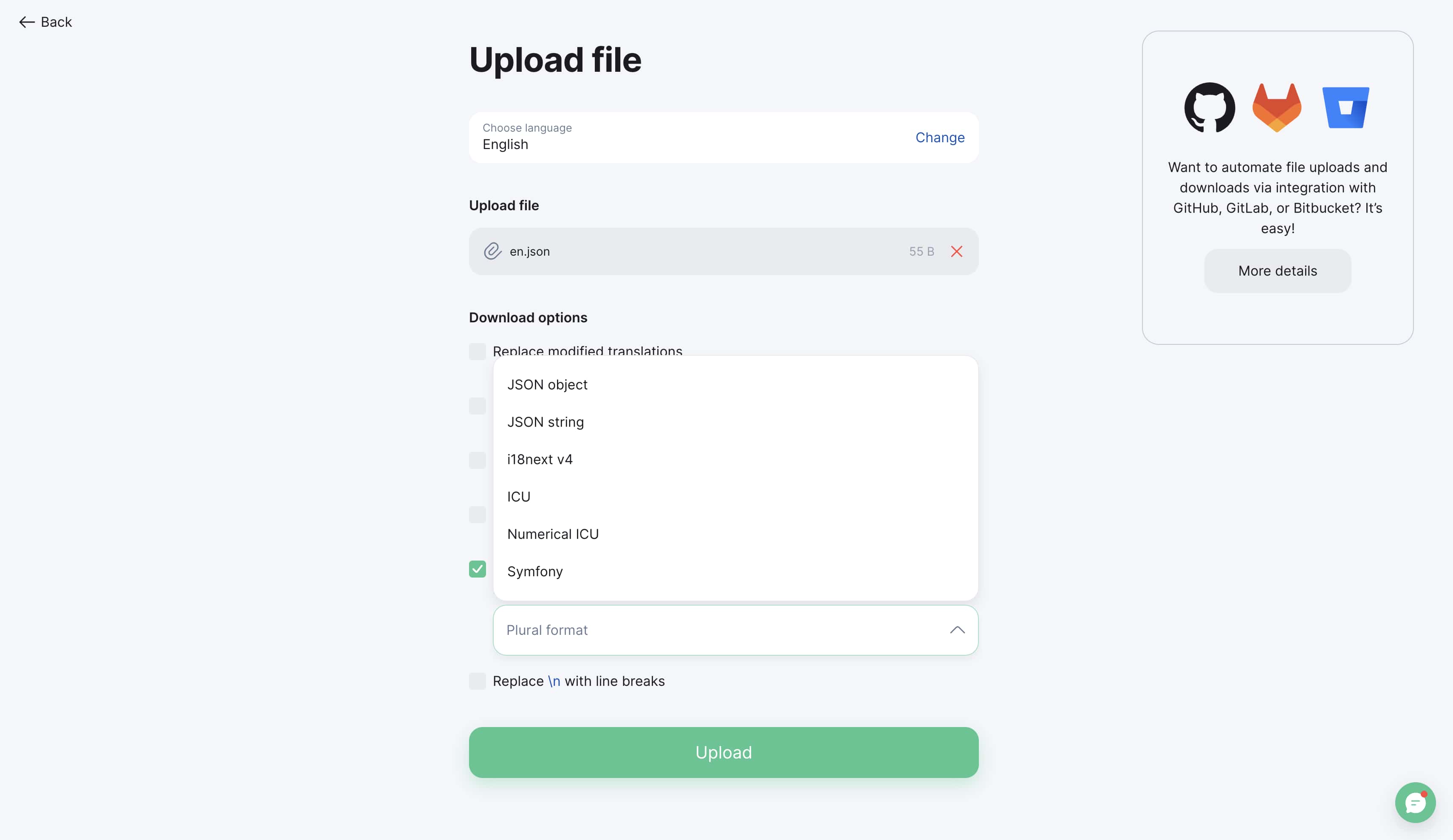JSON Format Guide
JSON is a lightweight, text-based data interchange format that's widely used for web applications and modern development frameworks.
Why choose JSON?
Universal compatibility — Supported by virtually every programming language and framework
Simple structure — Easy to read, write, and parse
Flexible organization — Supports both flat and nested key structures
Web-standard — Native format for JavaScript and modern web frameworks
Basic structure
Simple key-value pairs
{"welcome": "Welcome to our app!","login": "Log in","signup": "Sign up","cancel": "Cancel"}
Nested structure
{"auth": {
"login": "Log in",
"signup": "Sign up",
"forgot_password": "Forgot password?"},"navigation": {
"home": "Home",
"profile": "Profile",
"settings": "Settings"}}
With variables
{"welcome_user": "Welcome, {{username}}!","items_count": "You have {{count}} items","price_display": "Price: ${{amount}}"}
Plural forms in JSON
JSON supports multiple plural formats in Localit.io:
JSON object format
{"files": {
"one": "{{count}} file",
"other": "{{count}} files"}}
JSON string format
{"files": "{{count}} file | {{count}} files"}
i18next v4 format
{"files_one": "{{count}} file","files_other": "{{count}} files"}
ICU format
{"files": "{count, plural, one {{{count}} file} other {{{count}} files}}"}
Important: When uploading JSON files with plurals, select the correct plural format in upload settings for proper recognition.
Character encoding and special characters
Encoding
Always use UTF-8 encoding for JSON files to ensure proper display of international characters.
Escaping special characters
{"quotes": "He said \"Hello world\"","backslash": "Path: C:\\Users\\Name","newline": "Line 1\nLine 2","unicode": "Copyright \u00A9 2024"}
Common escape sequences
-
\"— Double quote -
\\— Backslash -
\n— New line -
\t— Tab -
\r— Carriage return -
\uXXXX— Unicode character
Working with JSON in Localit.io
Upload process
-
Select JSON format during file upload
-
Choose appropriate plural format if your file contains plurals
-
Enable "Convert to universal placeholders" for multi-platform projects
-
Configure other upload settings as needed

Key organization
Localit.io preserves your JSON structure:
-
Flat keys:
"welcome","login","signup" -
Nested keys:
"auth.login","auth.signup","navigation.home" -
Array keys: Handled as separate translation units
Export options
When exporting to JSON, you can:
-
Maintain original structure — Keep your nested organization
-
Choose placeholder format — Export with different variable formats
-
Filter by status — Export only completed translations
-
Customize file naming — Set specific file names for each language
Best practices
Organize keys logically
✅ Good structure:{"auth": {
"login": "Log in",
"logout": "Log out",
"signup": "Sign up"},"errors": {
"network": "Network error",
"validation": "Invalid input"}}
❌ Poor structure:{"login": "Log in","error1": "Network error",
"signup": "Sign up","error2": "Invalid input"}
Use descriptive key names
✅ Good naming:{"button_save": "Save","error_network_timeout": "Connection timeout","message_welcome_new_user": "Welcome to our platform!"}
❌ Poor naming:{"btn1": "Save","err": "Connection timeout","msg": "Welcome to our platform!"}
Handle plurals consistently
✅ Consistent plural structure:{"files": {
"one": "{{count}} file",
"other": "{{count}} files"},"messages": {
"one": "{{count}} message",
"other": "{{count}} messages"}}
Keep values concise
-
Use short, clear text for mobile interfaces
-
Consider character limits for different platforms
-
Avoid overly long sentences that might not fit UI elements
Common frameworks and libraries
React/React Native
import translations from './locales/en.json';
function MyComponent() {
return <Text>{translations.welcome}</Text>;
}
Vue.js with vue-i18n
{"welcome": "Welcome!","user_greeting": "Hello, {name}!"}
Angular with ngx-translate
{"WELCOME": "Welcome!","USER_GREETING": "Hello, {{name}}!"}
i18next
{"welcome": "Welcome!","user_greeting": "Hello, {{name}}!","files": {
"one": "{{count}} file",
"other": "{{count}} files"}}